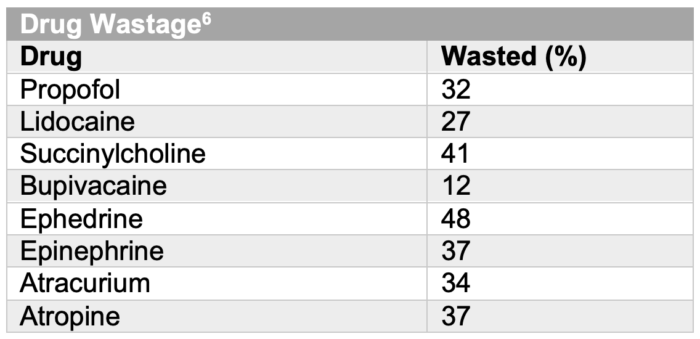Copy link
Prefilled Syringes
Last updated: 09/10/2024
Key Points
- Prefilled syringes (PFS) increase patient safety by reducing drug preparation errors and streamlining anesthesiology work processes.
- PFS may minimize medication waste and improve resource utilization.
- Decreasing medication waste reduces pharmaceutical contamination in the environment.
Medication Errors
- Medication errors include incorrect dosing, substitutions, omissions, syringe and vial swaps, and labeling errors.
- In a 2016 prospective observational study at a tertiary academic medical center with 64 operating rooms, 153 medication errors were documented over an 8-month period.
- The most common overall error was mislabeling (N=37; 24.2%), followed by administering the incorrect dose (N=35; 22.9%) and medication omission/failure to treat (N=27; 17.6%).1
- The rate of perioperative medication error was calculated to be 1:20.1
- A 2005 Australian Incident Monitoring Study database revealed that syringe and drug preparation errors accounted for 50.4% of incidents relating to drug errors occurring in operating settings or recovery units.2
Prefilled versus Self-Filled Syringes
- PFS are prepared and packaged in a sterile environment by pharmacists or industrial pharmaceutical companies. They contain a specific volume and concentration of medication and often have enhanced labeling, including color-coating.
- A self-filled syringe contains medication drawn from a vial.
- PFS eliminate the need for reconstituting or diluting medications, which reduces the chances for dosing errors to occur.3
- PFS decrease the number of steps required between selecting and administering a medication, which lowers contamination risk, eliminates labeling errors, and reduces opportunities for drug preparation errors.3
- Medication errors are not completely mitigated by using PFS in the perioperative environment. For instance, differences in medication workstation layouts can contribute to misreading labels, especially after care transfers.3
Medication Waste
- Medication waste can be described by the means of its generation.4
- Unavoidable waste: residual medication from an opened vial; a used syringe that must be discarded.
- Avoidable waste: medications that are opened/drawn but not used.
- Both self-filled and PFS may contain excess medication volume, which leads to medication waste.3 However, compared to self-filled syringes, PFS may minimize medication waste levels by encouraging quantity-limited, delineated amounts of medication per patient and procedure.4
- Unlike self-filled syringes, PFS can be returned to stock if unused, significantly reducing waste. This is particularly relevant to the availability of emergency medications (e.g., ephedrine, epinephrine, phenylephrine, and succinylcholine). PFS for these medications, which are readily available and ready to administer, can be returned to stock if unused and obviate the need to draw up emergency medications for every case.3,4
Environmental Impact
- Reducing the amount of avoidable waste is key.
- PFS have the potential to decrease the environmental impact of medication waste while maximizing resource utilization.5 As a result, PFSs could decrease the overall environmental impact of the health care industry.5
- A 2012 study of drug wastage in the operating room found that emergency medications had high percentages of waste (% of prepared medication that was wasted, Table 1).6

Table 1. Percentage of prepared anesthesia medications that were wasted
References
- Nanji KC, Patel A, Shaikh S, et al. Evaluation of perioperative medication errors and adverse drug events. Anesthesiology. 2016; 124(1): 25-34. PubMed
- Abeysekera A, Bergman IJ, Kluger MT, et al. Drug error in anaesthetic practice: A review of 896 reports from the Australian incident monitoring study database. Anaesthesia. 2005; 60(3): 220-7. PubMed
- Yang Y, Rivera AJ, Fortier CR, Abernathy JH 3rd. A human factors engineering study of the medication delivery process during an anesthetic: Self-filled syringes versus prefilled syringes. Anesthesiology. 2016; 124(4): 795-803. PubMed
- Gordon D. Sustainability in the operating room: Reducing our impact on the planet. Anesthesiology Clinics. 2020; 38(3): 679-92. PubMed
- Bukanova EN, Tunceroglu H. Pre-filled syringes: Reducing waste and improving patient safety. ASA Monitor. 2018; 82:16–17. Link
- Mankes RF. Propofol wastage in anesthesia. Anesth Analg. 2012;114(5):1091-2. PubMed
Copyright Information

This work is licensed under a Creative Commons Attribution-NonCommercial-NoDerivatives 4.0 International License.